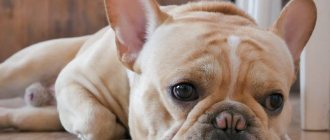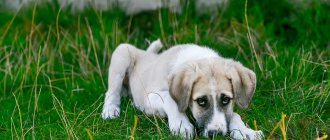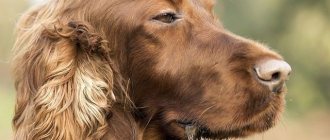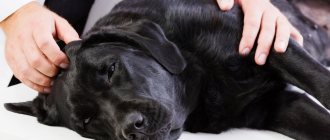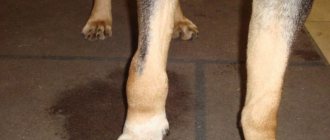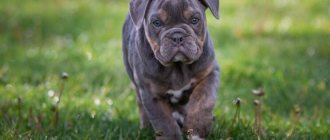How can a dog get shingles?
Ringworm in dogs is fungal and viral in nature. A four-legged friend can “catch” the disease in several ways:
- through direct contact with a sick animal;
- through household items (bowl, leash, collar, comb, etc.) belonging to an infected dog;
- through soil, grass and so on.
The likelihood of developing lichen increases significantly if the animal has reduced immunity. This condition may be caused by the dog’s pregnancy or lactation, a recent infectious disease, or a poor diet. The protective forces are also reduced if the pet has been taking corticosteroids for a long time, as well as if he has a malignant tumor.
Stray animals and those living in poor conditions constitute a special risk group. Dampness, lack of hygiene, high density (for example, in shelters) and other factors provoke the rapid spread of fungus.
Note: dogs with long and thick hair require special attention from owners. Due to the nature of their hair, their skin is poorly ventilated, which makes such pets the most vulnerable to infection.
Symptoms at the onset of the disease
What symptoms of ringworm in dogs should you pay attention to first? The latent period of the disease, on average, lasts about 10-14 days, depending on the type of lichen. Only after this do signs of the disease become noticeable.
At the initial stage of deprivation, the owner will notice the following manifestations:
- the animal scratches the same place;
- in the area of itching, superficial skin damage is noticeable in the form of discoloration, broken hairs, cracks, peeling and others;
- gradually the spot increases, new lesions appear;
- the dog becomes lethargic.
In most cases, skin lesions occur on the pet's paws, lower abdomen, and face.
Action must be taken quickly, as the disease is spreading at high speed. In addition, reduced immunity and damaged skin surface favor the addition of a bacterial infection and the development of other diseases.
General information about lichen
Ringworm in dogs is a very broad concept, as it combines a number of skin diseases. They are caused by different pathogens - fungi, viruses, etc. But the phenomenon has one common feature, regardless of etiology - pathological skin lesions in various forms. Weeping wounds, hair loss, papules, changes in skin color, itching, suppuration are what we used to call lichen!
The main types of lichen in dogs:
- shearer,
- pink,
- weeping,
- multi-colored (pityriasis),
- encircling.
Let's look at the possible types, control measures and diagnostics of lichen further.
Photos of lichen in dogs
Types of lichen in dogs
Several types of lichen are diagnosed in dogs, each of which has its own nature, symptoms and treatment approaches. That is why veterinarians insist that if they discover suspicious spots on their pet’s skin, the owners should immediately contact the clinic. At the same time, every owner should know what this or that type of disease looks like. This will allow you to quickly take preventive measures for household members (some fungi can be transmitted to humans) and for the animal (to stop further spread).
Pityriasis rosea
Pityriasis rosea is an allergic reaction to an infection, presumably of a viral nature. Most experts associate the development of this type of disease in domestic dogs with a genetic predisposition. Skin lesions, as a rule, occur against the background of viral diseases of the digestive tract, respiratory system, and after vaccinations.
Pityriasis rosea in dogs
Pityriasis rosea is characterized by a chronic course, so it is not possible to completely cure the animal. The disease occurs every time the pet’s immune system activity decreases: under stress, poor diet, and frequent illness. At the same time, the dog is not a source of danger to other animals and humans. However, if they have the same predisposition and low immunity, the likelihood of infection - even if it is miniscule - exists.
How to recognize pityriasis rosea in a domestic dog? This type is characterized by the following clinical picture:
- spots do not exceed 2 cm;
- the affected areas have a pink tint with a yellowish center;
- the bulk of the rashes are localized in the groin, on the face;
- the lesions are gradually destroyed with the formation of yellow areas with peeling of the epidermis.
Attention: pityriasis rosea can be complicated by the penetration of fungi, bacteria, and viruses into the skin, so treatment should not be delayed.
Ringworm
Ringworm on a dog's face
Ringworm is the dog’s body’s immune response to an allergen; eczema, which is not based on an infectious nature. An allergen can be any substance (medicine, food, etc.), hormonal disorders. The disease is chronic and manifests itself with the following clinical picture:
- swelling appears on the surface of the skin, hot to the touch, itchy and painful;
- bubbles gradually form in their place;
- baldness occurs in the affected area;
- discharge from the blisters gradually becomes purulent;
- The most common localization is the cheeks, tailbone, and neck.
As the skin heals, it becomes crusty, revealing healthy tissue underneath.
Since tinea versicolor brings significant pain to the dog in the form of itching, it begins to scratch the skin vigorously. This can cause an increase in the area of the affected areas and the addition of infection.
Ringworm
Ringworm in a dog
Unlike previous types, ringworm (clipped) is a fungal disease. Its development is caused by the penetration of fungi of the genus Microsporum or Trichophyton into the skin, causing, respectively, microsporosis or trichophytosis. Ringworm is a dangerous and contagious disease that can be identified by the following signs:
- small skin lesions (about 20 mm);
- color of spots – from pinkish to brown;
- their outline is clearly visible;
- localization – base of the tail, limbs;
- severe itching;
- baldness of the affected areas.
The infection is characterized by a rapid rate of spread. If no action is taken, the fungus can lead to the death of the dog in a short period of time.
Pityriasis versicolor
Pityriasis versicolor in a dog
This type of disease is caused by a yeast fungus of the genus Malassezia, which normally lives on the surface of the skin of not only dogs, but also other animals and people. In the absence of damage to the epidermis and strong immunity, the microorganism does not show aggression. Otherwise, the fungus multiplies vigorously, releasing large quantities of caustic acid, which literally “corrodes” the epidermis.
Another name for lichen is multicolored. This is due to the different shades of the lesions: pinkish, brown, brownish. Another sign is baldness in the affected areas. Since the spots quickly enlarge and merge, the disease can spread throughout the dog’s entire body in a short time.
The main signs of pityriasis versicolor in dogs and cats
The fungus affects the hair follicles, which negatively affects the animal's coat, causing seborrhea and baldness. If the infection gets on the claws, they peel off and collapse.
The spots are yellow-brown in color, the edges resemble lace. They peel off, become covered with bran, and if left untreated, merge with each other. There is not always itching. In winter, the spots may disappear.
How to treat lichen in cats and dogs
Tinea versicolor is a non-contagious disease, so the pet does not need to be isolated. Therapy is similar to the actions for the ringworm form - Vakderm, Yam, Zoomikol. Make sure that the animal does not lick the medicine for lichen, otherwise it may be poisoned.
Pay special attention to immunity - take care of good nutrition, give vitamins and minerals. In summer, walk with the animal in the morning and evening, avoid direct sunlight. If your home has air conditioning, turn it on.
Diagnostics
Before treating a dog for lichen, it is necessary to diagnose the identified pathology and differentiate it from other skin diseases. Ringworm in dogs can be confused with diseases such as dermatosis, pyoderma, seborrheic eczema, pityriasis versicolor and pityriasis rosea.
The following methods are used for diagnosis:
- illumination with a Wood's lamp;
- wool analysis (seeding);
- skin biopsy.
Microscopic examination reveals the presence/absence of spores and mycelium; culture makes it possible to determine the type of fungus. In addition, laboratory tests of the pet’s urine and blood are required. Additionally, the doctor may prescribe allergy tests and tests.
What can you do to speed up your recovery?
How to cure a dog from lichen without causing complications? The main condition is strict adherence to the recommendations of the veterinarian. The animal must be given medications in strict accordance with the prescribed course and dosage, without skipping doses. Unauthorized replacement of one medicine with another, as well as termination of therapy prematurely, is not allowed. The dog owner should be prepared for the fact that in some cases treatment may take a month or more.
Treatment with special shampoos that contain antifungal components will help speed up the recovery of your four-legged friend and prevent the spread of infection. Such hair care products are gentle on the surface of the skin, but using them for a long time is not recommended. To avoid excessive dryness of the epidermis, follow the instructions.
How to prevent your dog from licking ointment and scratching
Foci of lichen cause severe itching in the pet. When he scratches the affected area, the infection spreads to adjacent healthy tissue, which significantly delays recovery. The same thing happens if the animal licks the applied ointment.
If the lesions are single, you can seal them with a plaster or bandage them, after applying a gauze swab with ointment to the affected area. It is possible to prevent scratching of large areas using a special collar. If the dog resists such a device and removes it, you should put a jumpsuit on it.
Symptoms
The symptoms of the disease are multifaceted and can easily be confused with simple skin irritation, allergies and other dermatological problems. The development of pityriasis rosea begins with the appearance of red spots on the pet’s skin. The diameter of the rash is not large at first - from a millimeter to a couple of centimeters maximum. The shape of such places is round or slightly oval. In the middle of the spots, the skin has a different, more yellow tint and is also rougher than normal.
During the first week, the skin on the affected areas begins to peel off. Swelling and local hyperthermia (local increase in temperature) develop. However, the rash areas do not increase in size for a long time. Common locations for pityriasis spots are the lips, cheeks, neck, inner thigh, groin, and abdomen.
The pet's general condition may also deteriorate. Possible occurrence:
- increased body temperature;
- loss of strength;
- exhaustion;
- severe itching and pain;
- increased blood pressure.
Often ringworm is accompanied by dermatomycosis (fungal skin diseases - trichophytosis, microsporia). In this case, the merged diseases bring even more pronounced discomfort to the sufferer. Inflammation intensifies, the area of skin damage expands, and crusts of drying discharge appear.
Can iodine be used to treat ringworm?
The use of iodine to treat ringworm in dogs depends on the pathogen identified. So, with the ringworm type of the disease, this drug has the most effective effect. It is not recommended to use iodine solution for pityriasis rosea. In other cases, the remedy does not lead to any pronounced result. It should be noted that some veterinarians are categorically against the use of iodine for lichen. Judging by the reviews, you should not try to cure an unusual “spot” on your own using iodine as a panacea - this can lead to disastrous consequences for the dog.
Treatment at home
Many owners are prejudiced against veterinary clinics, believing that all the necessary manipulations for the dog can be done independently, and veterinarians are only interested in their own profit. Experts are not inclined to call non-drug remedies unambiguously bad. They can cope well with swelling, irritation, and redness. But they cannot eliminate the main cause of ringworm - fungi.
So, we can say with confidence that in most cases it is impossible to cure lichen at home without contacting a veterinarian. The only exception is the very beginning of the disease. But even in this case, reasonable caution must be exercised, since the same alcohol solution can seriously damage the dog’s skin.
Iodine must be applied to the affected areas of the animal's body with great care to avoid burns.
Popular folk remedies that, according to numerous statements, can cope with lichen in dogs include:
- iodine (the affected areas are lubricated four times a day. The dog should not be allowed to lick itself!);
- apple cider vinegar (apply to stains five to six times every 24 hours).
It is best to put a special medical collar on the dog to prevent it from licking itself.
Protective collar for dogs
Nutrition for dogs during the treatment of lichen
Treatment of lichen in dogs must necessarily be accompanied by a change in diet. This is especially true for pink and weeping types of the disease, which are allergic in nature. A special diet is designed to minimize the toxicity and allergenicity of certain foods and substances. The following should be excluded from the diet:
- potato;
- chocolate;
- sweets;
- smoked meats;
- spices;
- any products containing dyes, flavors, preservatives and other additives.
In case of weeping lichen, you will need to remove meat and meat products from your pet’s menu for a while.
How to apply ointment correctly
The better prepared the affected area of a dog's skin for lichen, the greater the effect that can be achieved from the medicinal ointment, so every owner should know the algorithm of actions when treating an infectious source.
- Prepare the following items in advance: medical rubber gloves, blunt-tipped scissors, a metal container and matches, soap solution, antiseptic (furacilin, chlorhexidine, hydrogen peroxide), tweezers, gauze wipes, medicinal ointment.
- Before proceeding directly to the procedure, put on gloves.
- The affected area of skin is treated with an antiseptic solution.
- If there is hair along the periphery of the lesion, the hair is carefully cut at a distance of approximately 5 mm from the affected epidermis. The cut hair is immediately burned.
- If there are scabs, soak them in a soap solution until completely softened.
- The scabs are removed with tweezers, and the area is again treated with an antiseptic.
- Use a napkin to remove any remaining moisture.
- Apply ointment.
Upon completion of treatment of all affected areas, the clipped wool and napkins should be burned.
Can humans or pets become infected?
Every dog owner should know what type of lichen is transmitted to humans and other animals. Regarding ringworm, the answer is clear - this disease is highly contagious and very contagious. When diagnosing it, the animal must be isolated from other pets and household members (especially children).
Ringworm does not pose a danger to others, as it is eczema of allergic origin. Regular hygiene measures when caring for a sick pet are quite sufficient.
The possibility of transmission of infection with pityriasis rosea is currently questionable. The opinions of experts of different specializations contradict each other: some believe that this disease is contagious, others say the opposite. In general, it is generally accepted that if a person has a strong immune system, then pityriasis rosea is not dangerous for him. If the immune system fails (due to age, illness and other reasons), then it is best to stay away from the animal.
Pityriasis versicolor also does not pose a danger to humans and animals, since the fungus is also present on the surface of their bodies. There is a theoretical probability that household members will develop the disease if their immunity is greatly reduced, so if your apartment contains a dog with pityriasis versicolor, it is better to play it safe and isolate it from children, the elderly or weakened people.
Danger to humans and pets
Only certain types of lichen can be transmitted to people or other animals. The biggest threat is ringworm. It is extremely contagious, so it is important to quarantine. Ringworm is completely safe because it does not spread through contact.
Pityriasis rosea can be dangerous if the immune system is weakened due to the disease . However, debate about its contagiousness still circulates among specialists. In any case, you shouldn’t be afraid of it, but it’s better to follow all hygiene standards. The situation is similar with pityriasis versicolor. Usually, it does not apply to people or other pets. But if the body’s resistance is greatly reduced, there is a possibility of infection.
Is there a vaccine against ringworm in dogs?
You can prevent the development of lichen in a dog by administering a special vaccine. The drugs Vakderm and Mentavak have good reviews. These are intramuscular injections that contain inactive fungi that cause lichen. Vaccines can be given after examining your four-legged friend, deworming, and examination by a veterinarian. Vaccines can also be used if the animal is already suffering from shingles. Self-administration of injections is not recommended, since the dosage and course require an individual approach.
Signs of ringworm
The incubation period ranges from eight to forty days. Usually, even before external symptoms appear, the dog makes it known that its health is far from satisfactory. The animal may become sad for no reason, refuse to eat, and not communicate with its owners. Then external manifestations begin - spots appear on the tail, head, especially in the area behind the ear, and at the bottom of the paws. The spots are round, small, clearly outlined. The hairs completely fall out of them, then the skin begins to peel and itch, and the color of the integument changes.
Signs of lichen in a dog
Then nodules filled with liquid appear, the skin becomes uneven and becomes covered with a crust. Another obligatory companion of any ringworm is severe itching, sometimes reaching unbearable. A person and a dog, when sick, experience constant discomfort and scratch the affected areas, which then change color and bleed.
Attention! The disease can ruin not only the dog’s fur coat, but also the dog’s claws. This is indicated by a change in shape and separation of the claws.
Prevention of lichen in dogs
You can prevent the development of lichen in dogs by following a number of preventive measures:
- protect your pet from contact with unfamiliar and homeless animals;
- observe sanitary and hygienic standards, wash the dog in a timely manner with suitable products (including preventative ones);
- feed your pet correctly, avoiding the presence of possible allergens in the food;
- ensure that the animal’s diet is complete;
- get vaccinated in a timely manner;
- do not limit your pet on walks;
- avoid using extraneous bowls, collars and other household items;
- Treat identified diseases in a timely manner, avoiding a strong decrease in immunity.
Every year, microbes undergo mutations and become more and more resistant to the drugs used, so a single and 100% effective treatment regimen for lichen in dogs has not been developed. In addition, each animal reacts differently to the medicine and the causative agent of the disease, which also affects the speed and effectiveness of therapy.
However, shingles in dogs can be cured. To do this, you need to quickly respond to the symptoms, bring your pet to the clinic, follow the specialist’s recommendations and continue to follow preventive measures.
How to recognize the disease?
Every responsible owner should know what signs indicate the presence of lichen in a dog. Failure to identify the problem in a timely manner can result in long and problematic treatment.
The first symptom of lichen in a dog may be restless behavior: the dog scratches the infected area of skin for a long time, gets nervous, and refuses its favorite treats. With these signs, it is worth carefully examining his body.
There are three stages of lichen in dogs:
- slight rash on the skin in the tail and head area, including on the ears;
- the appearance of spots, the formation of a bald patch in the affected area;
- thinning of hair, the appearance of crusts and scales.
Photos will help you see what lichen looks like in dogs at each stage of the disease. In addition to aesthetic problems, the disease causes discomfort in the form of annoying itching. The infection should be stopped at the initial stage to avoid further spread.
